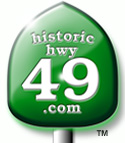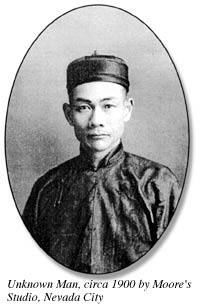                

|
The Nevada City, California Chinese Quarter
 The discovery of gold in California attracted miners from diverse backgrounds, all with the goal of striking it rich. Among them were the Chinese who, drawn together by a common language, settled in camps scattered along the tributaries of the Yuba and Bear Rivers. The 1852 census showed 3,396 Chinese living in Nevada County. By 1880, they constituted 22% of California's mining population making them the largest single nationality engaged in mining. The discovery of gold in California attracted miners from diverse backgrounds, all with the goal of striking it rich. Among them were the Chinese who, drawn together by a common language, settled in camps scattered along the tributaries of the Yuba and Bear Rivers. The 1852 census showed 3,396 Chinese living in Nevada County. By 1880, they constituted 22% of California's mining population making them the largest single nationality engaged in mining.
Nevada County towns such as Grass Valley, French Corral, North San Juan, North Bloomfield, Washington and Nevada City had a commercially-oriented Chinese community that served the unique needs of the Chinese miners. As other nationalities set up their businesses in centrally located towns, so did the Chinese. Nevada City's Chinese Quarter was well established by the 1860's. Here the hard-working miners from along Deer Creek, ditch diggers from North Bloomfield or cord-wood cutters from Washington could find a place to buy supplies and socialize with those who spoke a common language. General stores provided traditional foods from home, clothing and tools, as well as a place to pick up mail, messages and local news of the day such as job and investment opportunities. The Chinese Quarter had a temple for spiritual practices and offered brothels, gambling halls and opium houses for relaxation and recreation. Other services included doctors, herbalists, barbers, laundries, boarding houses and places to eat. There were assay offices and gold buyers as well. The Chinese Quarter was also a place to gather for special celebrations such as Chinese New Year.
Nevada City's Chinese Quarter once extended along Commercial Street from South Pine past York Street, all the way to the top of Broad Street. There were also Chinese businesses along the upper part of Broad Street. In the area where the parking lot and monument site are located today were a slaughter yard, vegetable gardens and a temple. A barbershop, general stores, brothels, and dwellings were also located in this area above York Street.
Most of the original buildings were simple structures made of locally milled lumber. It was not unusual for wooden structures to catch fire. Nevada City had many fires over the years and the Chinese Quarter was no exception. When a major fire in June of 1880 devastated the Chinese Quarter, Nevada City passed an ordinance stating "all Chinese shall be removed from Nevada City within sixty days." This was during a time when such ordinances against the Chinese were common throughout California. Attorneys for the Six Companies, a powerful Chinese organization based in San Francisco, argued against the ordinance in Nevada City and similar ones in other mountain towns. Although a "new Chinatown" was established just outside of town, the city could not effectively prevent the Chinese from re-establishing themselves along Commercial Street between York and Pine.
 The nineteenth century Californian attitude toward the Chinese was patronizing at best. The Chinese made undeniable contributions to the economy of the frontier west by providing a reliable source of inexpensive labor and by offering a wide range of services such as laundries, garden fresh vegetables, firewood and domestic services. They also bought tools, supplies and mining equipment from American manufacturers. Nevada County collected $103,250.00 in Foreign Miners Tax almost exclusively from the Chinese between 1850 and 1870. When the Transcontinental Railroad was completed in 1869, thousands of unemployed Chinese went looking for work. At the same time California experienced an economic depression for which the Chinese were blamed. In 1882, Congress passed the Chinese Exclusion Act, which suspended the immigration of "laborers" and prohibited naturalization of the Chinese. After 61 years, President Roosevelt repealed the Chinese Exclusion Act on December 13, 1943. The nineteenth century Californian attitude toward the Chinese was patronizing at best. The Chinese made undeniable contributions to the economy of the frontier west by providing a reliable source of inexpensive labor and by offering a wide range of services such as laundries, garden fresh vegetables, firewood and domestic services. They also bought tools, supplies and mining equipment from American manufacturers. Nevada County collected $103,250.00 in Foreign Miners Tax almost exclusively from the Chinese between 1850 and 1870. When the Transcontinental Railroad was completed in 1869, thousands of unemployed Chinese went looking for work. At the same time California experienced an economic depression for which the Chinese were blamed. In 1882, Congress passed the Chinese Exclusion Act, which suspended the immigration of "laborers" and prohibited naturalization of the Chinese. After 61 years, President Roosevelt repealed the Chinese Exclusion Act on December 13, 1943.
Mortality as well as the Exclusion Act reduced the Chinese population in California from 75,132 in 1880 to 45,753 in 1900. By 1900, Nevada County's Chinese population was 632 as compared to 3,003 in 1880.s
This information courtesy of 19th Century Chinese Gold Rush Historians, Wally Hagaman and Hank Meals.
Photos courtesy of the Nevada County Historical Society, and the Calaveras County Historical Society |


 The discovery of gold in California attracted miners from diverse backgrounds, all with the goal of striking it rich. Among them were the Chinese who, drawn together by a common language, settled in camps scattered along the tributaries of the Yuba and Bear Rivers. The 1852 census showed 3,396 Chinese living in Nevada County. By 1880, they constituted 22% of California's mining population making them the largest single nationality engaged in mining.
The discovery of gold in California attracted miners from diverse backgrounds, all with the goal of striking it rich. Among them were the Chinese who, drawn together by a common language, settled in camps scattered along the tributaries of the Yuba and Bear Rivers. The 1852 census showed 3,396 Chinese living in Nevada County. By 1880, they constituted 22% of California's mining population making them the largest single nationality engaged in mining.  The nineteenth century Californian attitude toward the Chinese was patronizing at best. The Chinese made undeniable contributions to the economy of the frontier west by providing a reliable source of inexpensive labor and by offering a wide range of services such as laundries, garden fresh vegetables, firewood and domestic services. They also bought tools, supplies and mining equipment from American manufacturers. Nevada County collected $103,250.00 in Foreign Miners Tax almost exclusively from the Chinese between 1850 and 1870. When the Transcontinental Railroad was completed in 1869, thousands of unemployed Chinese went looking for work. At the same time California experienced an economic depression for which the Chinese were blamed. In 1882, Congress passed the Chinese Exclusion Act, which suspended the immigration of "laborers" and prohibited naturalization of the Chinese. After 61 years, President Roosevelt repealed the Chinese Exclusion Act on December 13, 1943.
The nineteenth century Californian attitude toward the Chinese was patronizing at best. The Chinese made undeniable contributions to the economy of the frontier west by providing a reliable source of inexpensive labor and by offering a wide range of services such as laundries, garden fresh vegetables, firewood and domestic services. They also bought tools, supplies and mining equipment from American manufacturers. Nevada County collected $103,250.00 in Foreign Miners Tax almost exclusively from the Chinese between 1850 and 1870. When the Transcontinental Railroad was completed in 1869, thousands of unemployed Chinese went looking for work. At the same time California experienced an economic depression for which the Chinese were blamed. In 1882, Congress passed the Chinese Exclusion Act, which suspended the immigration of "laborers" and prohibited naturalization of the Chinese. After 61 years, President Roosevelt repealed the Chinese Exclusion Act on December 13, 1943.